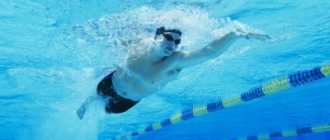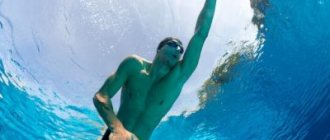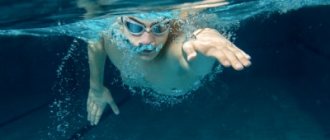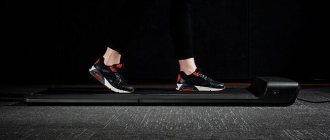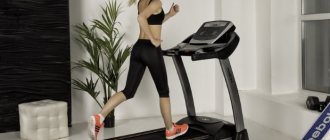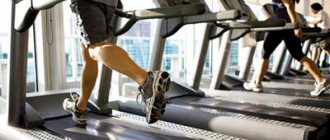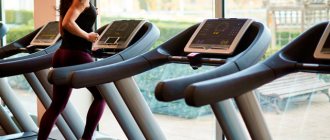The health benefits and harms of swimming
Benefit
Swimming is good for everyone - from babies to seniors.
It helps adult men and women get good exercise and relieve stress. Swimming doesn't put stress on your joints and uses all muscle groups. It's like athletics, only more effective and less traumatic. Health benefits of swimming:
- develops strength and endurance;
- helps the spine become more flexible;
- promotes weight loss;
- improves joint mobility;
- trains the lungs and heart;
- restores healthy sleep.
It is worth noting that the benefits of swimming for the spine, lungs and muscles are felt if you swim correctly. To do this, you need to learn to dive, paddle and glide through the water, without stopping at the achievement of “I can swim like a dog.”
Harm
It is no coincidence that a doctor’s certificate is required to swim in the pool: there are a number of diseases for which swimming is contraindicated.
For example, dermatitis, furunculosis, eczema and fungus are aggravated by water contact. In addition, skin diseases can be dangerous to others.
You also need to understand that swimming is a great physical activity for the whole body. Therefore, it is better for people with heart disease or cancer to consult a doctor.
Some chronic diseases of the lungs and intestines may also be a contraindication. Swimming is not recommended for people with epilepsy or seizures.
Why you just need to take up swimming
Water has a beneficial effect on a person’s physical and mental health. Swimming helps:
- Lose weight. The amount of calories burned while swimming is enormous. All muscle groups are involved in the work.
- Improve your posture. Today people move little and spend a lot of time in front of the TV or at the computer. Swimming relieves slouching and improves the condition of the lower back and back muscles.
- Get rid of belly fat. When swimming, not only your arms and legs work. The abdominal muscles also work actively.
- Make joints flexible. Swimming not only has a good preventive effect. Chilled water relieves pain during exacerbations, and smooth swimming movements act like a massage.
- Improve blood. Regular training in the pool has a positive effect on the body.
- Take a break from information. You will be away from your smartphone and the Internet for at least an hour. Swimming is a kind of digital detox.
- Relax. Water, movement and breathing help relieve tension and forget about problems. Reduced temperature has a beneficial effect on the nervous system.
- Temper and strengthen the body. Cool water in the pool is an excellent replacement for dousing with cold water.
- Fight temptations. Sometimes it is so difficult to fight temptations. Swimming improves your mood and the need for extra candy or alcohol disappears by itself.
Swimming can be done at any age. For adults, swimming is the safest way to stay in good physical shape.
Don’t waste time, study our recommendations and advice and join such a wonderful activity - swimming. We wish you to benefit from swimming and have a lot of fun!
Where to learn to swim?
Methods of teaching swimming are theoretical and practical. To learn the theory, you can read articles or books, watch training videos on the Internet. From theory you need to move on to practice - training on the water.
View trainer profiles
In a swimming pool
It is better to take your first lessons in the pool - in still water it will be easier for you to control your body position. Moreover, it is better to do this with a coach, so that later you do not have to correct errors in technique.
Natalya Pulcheva swimming coach
4,89 37
Open profile
Often students do not know how to breathe or how to lie on the water. The trainer will show and tell you how a person should feel in a certain position of the body. I train in the water: I show by example, and then I observe the student.
Tips for those who want to learn to swim in the pool:
- Pay attention to group classes. It's not only cheaper and more fun, but also more effective. You gain like-minded people, and with them the motivation and habit of going to the pool.
- If you are serious, then immediately sign up with a trainer. The main advantage of individual lessons is that all the attention is on you. This way you will master the technique much faster.
- At first, stay close to the side. You need to gradually get used to the water and feel that you are safe.
Advantages and disadvantages
A swimming pool is a specially organized place for learning to swim. This means that here you can not only safely gain your first skills, but also get rid of the main obstacle - the fear of water. Plus, training is available all year round. And this is a big plus, because regularity of classes is an important factor of success.
But you still need to find a good pool. And you will have to pay for the subscription. But there is a hidden advantage to this: financial motivation works. By giving the money, you will probably attend classes.
On open water
There are not many alternatives to the pool - a lake, river, sea or reservoir. And they are available mainly in the summer.
Advantages and disadvantages
Experts do not recommend learning to swim in a lake, river or sea for several reasons.
- Rivers and lakes have cold currents and springs, and uneven bottom topography. For an inexperienced beginner, swimming can turn into a tragedy.
- In the sea, the water is denser, it will “hold” you, and you won’t be able to feel the movements.
- Training will be irregular, from time to time.
- It is difficult to learn to swim in open water, because there are usually a lot of swimmers near the shore.
But open water also has its advantages: you can learn to swim and relax in nature. And you won’t have to pay like you do for visiting the pool.
At home
If no body of water, even an artificial one, is inaccessible to you, you can try to learn to swim at home. Of course, you can't do this in the bath. But there is so-called “land swimming” - training that helps prepare the body for the stress of water.
Advantages and disadvantages
Obvious advantages: you don’t need to travel anywhere, you can train in the comfort of your own living room. But there are more disadvantages: learning to swim at home without an instructor is almost impossible. Or rather, it is impossible to do it correctly. You won’t see yourself from the outside and even after a dozen videos you won’t be able to understand that you’re making technical mistakes
.
Useful tips
When starting your training, think through all the points and listen to the advice of experts. Choose a place where you will study. In any case, you will need to overcome your fear of water, otherwise you will never learn to swim confidently.
How not to be afraid of water?
There are plenty of ways to ease your fears of water. Some beginners are afraid to dive, others panic, fearing the depths. There are many exercises that help you “make friends” with water.
How to get rid of fears:
- Don't rush to go deep. It is contraindicated for a beginner. Start with the pool - you will feel safer there than in open water.
- Don't force things. Get used to the water before swimming. Learn to stick with it. Perform a set of exercises to help you feel the buoyant force of water - “star” and “float.”
- Swim with insurance. In the first lessons, a board or armbands will help you.
The most difficult moment in learning to swim is overcoming the psychological barrier. If you eliminate it, everything will be simpler. You will be able to concentrate on practicing the technique without being distracted by fighting your own fears.
Where is the best place to study?
In open water, beginners feel insecure. They are afraid of depth, shy of unnecessary glances and ridicule. A beginner is much more comfortable in the pool.
Benefits of training in the pool:
- safety;
- the presence of paths, belays, handrails and other attributes that help learning;
- the ability to perform any exercise;
- absence of currents, whirlpools, large and unpredictable depths.
If you study in open water, it has to be the sea. It contains salt water, which holds the human body much better than fresh water.
What kind of warm-up is needed?
Like any physical activity, swimming is recommended to be preceded by a warm-up. They start it on land and continue in the water.
Warm-up begins with simple movements - doing various swings. Gradually move on to more complex exercises - rotations - increasing amplitude and intensity. After warming up, muscles become more elastic and mobile, reducing the risk of strain.
Exercises on land:
- Walking, then running, jumping. Execution time – 2 minutes. The body warms up and becomes ready for subsequent loads.
- Head turns. This exercise is aimed at working the neck. After it, all the vertebrae fall into place.
- Scrolling your hands in different directions. Train your wrists.
- Rotation of arms at elbows. The exercise develops the elbow joints.
- Wave your arms. Development of shoulder joints. Exercise relieves tension and prevents injury.
- Rotation of the pelvis. Development of the hip department.
- Squats and knee rotations. Such movements train the calf muscles and develop the knee joints.
- Ankle rotation. The exercise is performed by resting your toes on the floor or holding them in the air.
The warm-up is completed with static and dynamic exercises. Improving flexibility helps stretch muscle fibers, which increases strength and endurance.
After warming up on land, move on to exercises in the water. They adapt the swimmer to the aquatic environment and help prepare for classes taking into account their well-being. There is no standard water warm-up program, but there are basic exercises recommended for use.
Exercises in water:
- Calm sailing. The movements are unhurried. Arms, legs, head and body practice technique.
- Exercises that involve only the arms or legs. Strokes are performed in a minimal amount.
- Movements that improve coordination of all parts of the body and swimming technique.
- Breathing training. He is detained during the dive and during the swim.
- Move short distances at average speed.
- Swimming to restore heart function and respiratory function.
The distance a swimmer swims during warm-up depends on his physical fitness. On average, it is 200-800 m. The set of exercises and their intensity are also affected by the state of the nervous system.
“Dry swimming”, or exercises for swimming on land
Dry swimming is a dry swim workout that mimics the movements of a swimmer. Exercise improves your fitness and helps you achieve results faster on the water. Many coaches give the dry-swimming routine as homework.
For dry swimming, athletes use their own body weight, fitballs, TRX loops and special exercise equipment - rubber. Exercises can be done at home or in the gym.
The training is structured according to the following scheme:
- Warm up and warm up muscles.
- Swings - swinging your arms to increase shoulder mobility.
- Strength exercises and working with rubber bands.
- Flexibility exercises that increase range of motion.
- Stretching and cool down.
It is best to find out whether you need dry swimming lessons from a trainer. Typically, such techniques are required by professional athletes, but can also be useful for adult amateurs. For example, to understand the principle of movement in water and practice the technique of swimming breaststroke, crawl or butterfly.
Is it worth going to the pool?
Swimming is possible, and most importantly, it is necessary. After all, this is the type of physical activity that can practically not cause damage. It's hard to imagine hurting your back or breaking an arm in the pool, unlike strength training. At the same time, all muscle groups are involved, which is very beneficial for health.
Another important advantage: swimming combines the loads obtained during aerobics and gym training. The first stretches the muscles, the second shortens, and exercises in the pool do both.
Therefore, swimming is an ideal option for those who want to look good, monitor their health, lose weight or simply maintain their figure. And now we will tell you how to learn to swim as an adult.
Breathing while swimming
You need to learn to breathe correctly from the very first training. This is the key to success in mastering more complex techniques.
Inga Sologub swimming instructor
5,0 44
Open profile
Breathing is the most important point in swimming. With the correct technique, take a deep breath through your mouth and exhale through your nose into the water. If we inhale and exhale through our mouths, we will be able to float on the water, but the air supply in our lungs will be used up faster.
The biggest risk of using the wrong technique is that water can get into your nose. This is something many people who learn to swim are afraid of. Exhaling through the nose provides protection from water entering the lungs.
You need to train your breathing in a pool or in shallow water, if we are talking about open water.
There are several exercises for this.
- Inhale through your mouth, drawing more air into your lungs, not through your cheeks. Submerge your face under the water and exhale through your nose. Try to gradually increase the duration of exhalation and decrease the inhalation.
- Repeat this exercise while lying on the water. To begin with, it is better to stick to the side. Take short breaths and slow exhales into the water.
- A more advanced type of breathing training when swimming: sharply raise your head above the water, take a short breath and exhale slowly.
- If you have a swimboard, you can do this exercise: hold on to it with one hand and use your legs. Every three seconds, turn your head to one side to inhale quickly and to the other to exhale long.
Such exercises not only help you understand the principle of proper breathing while swimming, but also develop your lungs.
Common mistakes when learning on your own
To perform all actions smoothly and accurately, regular training is needed. At first, almost all beginners make mistakes - major and minor.
Typical mistakes:
- Beginners worry and fuss, because of this their breathing becomes intermittent and shallow, but should be deep and rhythmic. If fatigue sets in, rest, and most importantly, do not breathe through your nose.
- Many people try to master all styles at once. This is wrong because it does not lead to results. Learn one style thoroughly first, then move on to another. It is recommended to start with crawl or breaststroke. But it’s better to leave the butterfly for later.
- Beginners often tighten their muscles and do not relax their body in any way. This interferes with swimming, the speed drops, and the swimmer gets tired quickly. Don't forget that staying on the water is impossible without relaxation.
- Swimming without nose and ear plugs. Many people think that this is unnecessary, but such devices were not invented in vain - they reliably protect the nasopharynx and ears from water.
- Different levels of upper and lower body training. Usually, beginners' legs get tired faster than their arms. It is important to focus your training on strengthening the leg muscles.
- Training without a trainer. This is not so much a mistake as a missed opportunity. Most adults need a competent and experienced leader. With it, learning goes faster and more efficiently.
If you didn't learn to swim as a child, you have the opportunity to improve the situation. How exactly you will master swimming techniques is up to you, but experts advise starting your studies in the pool, under the guidance of an instructor. In this case, you will be able to master basic techniques and styles in a short time.
How to float
Our body itself knows how to float on water: thanks to our lungs, we can stay afloat and not drown. Once you realize this, it will be much easier for you to learn. And to consolidate the skill, there are simple exercises.
Exercise "star"
The “star” is performed on the back or chest. The exercise helps you understand that with the correct body position you can lean on the water. The “star” on the chest is done like this:
- Go into waist-deep water.
- Raise your hands and take more air into your lungs.
- Push off the bottom and lie with your chest on the water.
- Extend your arms and legs to the sides. The face should be facing down.
Don't be afraid - the air in your lungs will keep you on the surface. The main thing is to straighten your limbs and spine. In this position, like a starfish, you will increase the area of pressure of your body on the water and will not sink under your own weight.
The exercise can be complicated: raise your head while lying on the water. Buoyancy will decrease, but you will understand that swimming with your head under the water is much more convenient.
For the “star” on your back, the execution algorithm is approximately the same: inhale deeply, lie on your back in the water, stretch your arms and legs in different directions. This option is a little more complicated, but it is a good way to overcome your fear of water.
Float exercise
“Float” helps you feel that thanks to the air in your lungs, your body can stay afloat regardless of your weight. Despite this, experts advise doing the exercise at shallow depths: the water should reach up to your chest, so that if something happens, you can immediately straighten up and rest your feet on the bottom.
You need to do the exercise like this:
- Take a deep breath.
- Pull your knees to your chest, clasp your hips with your hands.
- Lower your head under the water and press it to your knees.
- Don't panic, let the water push you to the surface.
Thanks to the air in your lungs, your body will turn its back upward and you will begin to float up like a float. You just need to find balance and slowly exhale the oxygen supply. And to avoid the temptation to take a breath, you can pinch your nose with a special clothespin.
How to swim to lose weight
Many people believe that using a swimming pool can help you lose weight. This is partly true, but you will have to do it for a long time and intensively - after all, this is not strength training, but cardio. That is, burning calories will begin only 40 minutes after the start.
It is extremely important to learn different swimming styles. This helps increase the load on different types of muscles and promotes weight loss. And, of course, we should not forget about proper breathing, because the body requires a lot of oxygen to burn fat.
To lose weight, you should also include water aerobics exercises, such as walking in water, running in place, and jumping.
However, it all depends on the swimmer's technique and training. Water is denser than air, and all exercises involve resistance for any muscle in the body. Metabolism works faster - this means that calories continue to be burned after the pool.
So swim to lose weight - but swim a lot. Regular exercise in the pool can be more effective than intense trips to the gym and is certainly healthier. And the result will be smooth, elastic, toned muscles and blurred contours of the body. And don't be afraid that your shoulders will increase in size and your arms will become huge. It is not true.
In any case, the main thing for an adult is to learn to swim as correctly as possible, otherwise the effect on the figure will be rather weak.
What you need for swimming: equipment and accessories
There are not so many mandatory things to do in the pool:
- swimsuit or swimming trunks;
- cap;
- towel, shampoo and shower gel;
- rubber slippers.
Young swimmers are advised to take children's swimming goggles. For training in the sports section, you can even buy a good model with a seal.
Some accessories are not required to be purchased. To figure it out, we made a table.
| Swimming trunks or swimsuit | Necessarily | It is better to choose a sports model. Beach shorts and swimsuits impair maneuverability in the water. |
| Mask | Not necessary | This is an accessory for scuba diving. |
| A tube | Not necessary | Accessory for snorkeling and diving. Newbies to the pool don't need them. |
| shoulder blades | Not necessary | Needed to practice the stroke, increase its speed and strength. |
| Board | Not necessary | With a board you don’t have to think about how to stay on the water. You can focus on moving your legs. |
| Vest | Required only in open water | The main means of safety in open water. |
| Wetsuit | Not necessary | Useful for diving. |
| Flippers | Not necessary | Can be used when learning to swim breaststroke and crawl. |
| Glasses | Not necessary | They will come in handy to see better under water and protect your eyes from irritation. |
| Oversleeves | Not necessary | Can be useful for learning to swim in open water, especially for children. |
| Nose clip | Not necessary | Prevents water from entering the nose. |
| Earplugs | Not necessary | Prevents water from entering the ear. |
Watch your breathing
The most important thing is to learn to breathe correctly. Here are some general rules to help you learn proper technique.
In the meantime, you need to try it in shallow water or in a pool with a shallow bottom.
- Be sure to inhale through your mouth, and exhale through your nose. At the same time, you need to start with it. Then you won’t suffocate, and water won’t flow where it shouldn’t.
- Water puts more pressure on the chest than air, so you need to breathe more sharply than on land. It is very important to literally hear your breath and release the air with the entire surface of your lungs.
- Don't hold your breath for a second. Then carbon dioxide will not accumulate in the body. Otherwise, it can lead to increased fatigue and even headaches. It is important to understand that the accumulated air also affects the position of the body: the legs fall in opposition to the chest.
- Exhale slowly and gently until your mouth is under water again. When you begin to inhale, your lungs should be completely empty of air.
So one of the answers to the question of how to learn to swim is right here: without proper breathing, further development of the technique will be impossible.
Swimming styles and techniques
There are several basic swimming styles:
- Crawl or freestyle
. In this technique you need to constantly move your legs and make alternating strokes. You can swim crawl on both your front and back. - Breaststroke
_ The arms make powerful strokes underwater, and the legs move like a frog. - Butterfly
. The arms make a powerful stroke, and the legs move like a dolphin's tail.
Swimming instructors say that you can start learning with any style, but the easiest way to start is crawl swimming.
Workout after swimming
This workout was created by American trainer Chris Houchens and is the perfect addition to your trip to the pool. You can do the exercises in shoes or barefoot; the floor can be covered with a towel.
1. Swooping superwoman
You need to lie face down, stretch your arms forward, put your feet together. Lift your front and hind limbs a few centimeters from the floor, then simultaneously raise your right arm and left leg another 15-20 cm. Swap them.
2. Bend down
Take the starting position of a push-up and get into dog pose: legs straight, heels slightly off the floor, hips raised. From this position, lower your hips, lift your hips, and shift your weight forward into upward-facing dog. And back.
3. Push-ups with a shifted center of gravity
Get ready for a push-up, then lower yourself down, closer to the floor, and return to the starting position. If it’s hard, you can bend your knees.
4. Swallow thigh
You need to stand up, bend your knees, raise your right leg and tilt your torso parallel to the floor, spreading your arms to the sides in line with your shoulders. If you cannot maintain your balance, you can grab onto a chair or other suitable support.
5. Bridge with props
You need to lie on your back, legs bent, feet on the floor. Hold the towel between your knees, but raise your hips so that your body is stretched in a straight line and the props do not fall. Hold this position, then lower your hips.
6. Star
Lie on your back so that your arms and legs form a star. Raise your head and limbs a few centimeters from the floor, bring your left arm and right leg closer to each other so that they can connect at the level of your stomach. Then do the same with the other side. Movements should be slow and smooth.
Crawl
Crawl, or freestyle, is the fastest type of swimming and most suitable for beginners. In addition, you can only swim the crawl on your back.
Front crawl swimming technique
When learning to swim front crawl, it is important to master the correct stroke, as well as learn to glide through the water and feel the balance of the body.
You need to keep an eye on the following things:
- Gather your fingers so that your palm turns into a “cup” and row alternately with your right and left hand. It is important not to hit the water, but to plunge your hand smoothly and confidently. To avoid splashing, the thumb should first touch the water, then the entire “cup”.
- Bend your shoulders and elbows at the beginning of the movement and fully straighten at the end. The main impulse of the arm movement should take place under water.
- Move your legs at the same time. The amplitude should be small, and the movements should be free and smooth. There are approximately two to three leg movements per stroke.
- Inhale air and release it into the water as you turn your head towards your raking hand. In this case, the face should always be lowered down, but the body should alternately turn in one direction or the other, depending on the phase of the stroke.
Backstroke swimming technique
Swimming crawl on your back is even easier than swimming on your front: you can row with straight arms, and you don’t need to immerse your face in the water. The main burden falls on the legs.
Basic Rules:
- To breathe correctly, turn your head towards the hand that is currently working above the water. For one inhalation there should be two or three cycles of hand work.
- Do not lift your head above the surface of the water - this will put additional stress on the spine.
- For an effective stroke, raise your elbow above the water.
- Make sure that your legs move evenly and without unnecessary effort. Start moving your legs from the hip, not the knee.
Exercises on dry land
One of the effective exercises for learning crawl on land is leg training:
- Lie on your left side and straighten your legs.
- Make small amplitude swings with your right leg. You should feel the anterior thigh muscle.
You can also work on your hands:
- Lunge forward and lean slightly towards your supporting leg.
- Imitate strokes using both hands alternately.
- Try combining the exercise with breathing.
It is important for professional rabbit climbers to develop strength and endurance. Therefore, there are sets of exercises for them not only on land, but also on water.
Water crawl exercises
To swim the crawl correctly, you need to hone your leg movement technique. Beginner swimmers are advised to use their legs, holding on to the side of the pool and lowering their head into the water.
Technique:
- Straighten your body, stretch your legs and relax them.
- Perform alternating swings with straight legs.
- Periodically raise your head to inhale and exhale slowly into the water.
The training can be gradually complicated: do the exercise with a board, with straightened arms, under water.
For the hands you can make the following link:
- Swim crawl using only one hand. Straighten the second one and press it to your body. The task is to swim 25 meters like this.
- Then swim, rowing with both hands alternately, but observing the following rules:
- Until one hand is completely out of the water to the fingertips, keep the other hand horizontal.
- When one hand reaches the top point, the second begins to move.
- Do not allow your arm to bend prematurely; keep it underwater, extended in front of you. One hand always rushes forward while the other works.
The exercises teach you to move your arms synchronously, maintain a constant speed and horizontal body position.
To practice hand technique, you can do alternating strokes with a board or train with the help of shoulder blades. This equipment helps increase stroke strength.
Advantages and disadvantages
The crawl technique involves constant movement. Because of this, you get tired quite quickly, even though the energy is spent evenly. For example, when swimming breaststroke, the swimmer gets less tired: he makes a movement that gives the body acceleration, and then glides through the water for some time.
Self-study exercises
There are several simple but effective exercises with which a person who does not know how to swim can quickly learn different styles. They allow you to master proper footwork, gliding techniques and other skills.
"Threshing"
With this exercise, beginners train lower limb endurance. It is the weakness of the legs that often interferes with the first stages of training.
How to do the threshing exercise:
- Grab a support, such as the side of a pool.
- With your body stretched back, work your legs - keep them straight and your toes pointed.
- Try not to create a lot of splashes. Because of them, the exercise becomes less effective.
“Threshing” is performed not only while holding onto a stationary support, but also when moving with a board.
In this video, an athlete performs a “threshing” exercise:
"Frog legs"
This exercise is universal - it is done both on land and in water. It teaches beginners to distribute the load evenly and allows them to practice the transmission of impulses from the upper limbs to the lower ones.
How to do the frog legs exercise:
- Hold onto a stationary support.
- Spread your legs slightly and bend your knees, turn your ankles at a right angle.
- Move your legs the way frogs do - push off from the water, straightening your legs, and then tuck them in.
Sliding after the float
One of the basic skills of a swimmer is gliding through the water. All sports swimming styles are based on it - butterfly, breaststroke, backstroke and front crawl. Master sliding from two positions – stationary and moving.
How to glide after the float exercise:
- Make a “float” and then sharply push off the side with your feet.
- Stretching out on the water, continue gliding for ten seconds.
- As you slide, keep your head straight with your face in the water.
Sliding exercises are shown in the following video:
Sliding after a push
Try the second sliding option - pushing off from the bottom or side:
- Make a sharp push with your feet from the side or bottom and stretch your arms forward.
- Rake the water with your arms straight, palms facing outward.
- Bring your arms under your chest and extend them forward.
- Make all movements slowly, putting in strength, do not fuss, so as not to reduce efficiency.
Here is a video about sliding:
Breaststroke
Rhythmic and fast swimming style. Suitable for long distance swimming. Breaststroke is taught after the beginner has mastered the basics and learned to glide through the water.
Breaststroke technique
All movements are done quickly, almost without pauses. To master breaststroke swimming techniques and build proper breathing, you need to practice. There shouldn't be any problems with your arms, but the specific movements of your legs will take some getting used to.
Here are a few simple rules to help you master the technique:
- Bend your elbows, bring your palms together and raise them to approximately shoulder level. Then extend your arms and make a sharp stroke with your arms underwater.
- Simultaneously with the stroke, push off the water with your feet, like a frog. The legs will give the impulse to accelerate.
- The body will rise above the water - use this moment to inhale. Raise your head, inhale and exhale lower it into the water before your arms make the next stroke. Don't throw your head back, look straight.
The body should be under water in one smooth line from head to toes. To do this, you need to pull in your stomach and relax your spine. A common mistake when learning to swim breaststroke is to leave your head above the water after inhaling - while exhaling, your face should fall under the water.
Exercises on dry land
Imitation on a bench or floor helps to understand the principle of breaststroke swimming.
Practice your leg movements:
- Stretch out with your legs straight and closed.
- Bend your knees and pull them towards you, pointing your toes out.
- Push your legs and return to the starting position.
Exercises for swimming breaststroke in water
In the water, practice your leg movements by holding on to the side or using a board: “turning off” your arms, you focus on the movements of your legs. Remember to raise your head as you inhale and lower it under the water as you exhale.
Advantages and disadvantages
You can learn breaststroke swimming on your own if you have good coordination of movements. It is not easy to develop synchronicity between arms and legs; you need some experience in communicating with water.
Breaststroke works well on the shoulder girdle, pectoral muscles and legs. But the spine practically rests, which is especially useful for people with bad backs.
How to move your arms, legs, body?
Swimming is a pleasant activity, but in order to learn how to move quickly and with minimal effort in the water, you have to hone the technique of performing each movement. Beginners make many mistakes when making movements with their legs, arms, and body.
Rules for performing movements:
- Move your arms and legs confidently, but keep them half relaxed. There shouldn't be any tension. It leads to rapid fatigue.
- Movements should be sweeping, amplitude should be maximum. In butterfly, imagine that your hands are like propellers, turning forcefully into the water. Make forward movements sharply - as if they were arrows piercing the surface of the water.
- As you swim, use every part of your body. Don't try to swim by just moving your arms and legs. With a heavy load on the arms, the shoulders get tired too quickly, and general fatigue sets in. To use your strength efficiently and swim quickly, work with your whole body. Observe the movement of fish and animals in the water. Notice how natural all their movements are. Try to imitate them, imagine that water is your habitat.
- Move your arms and legs in sync with your breathing. This is the main principle for successfully mastering any style of swimming.
Butterfly
Butterfly is a type of swimming in which all parts of the body move simultaneously. Because the legs are closed and their movements resemble those of a fish's tail, this technique is also called dolphin swimming. This style is considered the most energy-intensive.
Butterfly swimming technique
When swimming butterfly, the body constantly moves up and down: when the shoulder girdle lowers for the stroke, the lower back rises. And as the shoulders rise, the lower back sinks under the water. The technique is quite complex, so it is better to master it with a trainer.
Here are the basic rules:
- Extend your arms forward with your fingers closed. Then spread your arms out to the sides, keeping your elbows higher than your forearms. A stroke will occur, the body will rise above the water. At this moment you need to inhale.
- Bring your hands closer to your pelvis, then lift them above the water and quickly move them forward for the next stroke.
- Push with your legs closed, slightly bending your knees.
- For each stroke there are 4 kicks - down-up, down-up. The first two movements raise the head and shoulders, the second - the lower back.
The swimmer periodically lifts his chest out of the water to inhale. At the same time, breathing should also be rhythmic.
Exercises on dry land
Exercises to better understand leg movements:
- Stand with your back to the wall on one leg. Pull the second one forward slightly.
- Squat down, bending your supporting leg at the knee.
- Straighten your supporting leg and tilt your pelvis back.
- Take your other leg back and move your pelvis forward.
The legs move underwater during swimming using the same principle.
Exercise to practice body movements:
- Stand with your back to the wall at a distance of 20 cm.
- Bend over so that your shoulder blades touch the wall.
- Round your spine and “roll” it along the wall from your neck to your lower back.
- Touching the wall with your buttocks, straighten up and then bend at the waist.
Such a wave will help you understand how the body should move from the chest to the tailbone.
Exercises in water
To teach wave-like movements, you can do the following exercise:
- Take air into your lungs and lie down with your chest on the water. Keep your head straight, look down, relax your neck, stretch your arms in front of you.
- Make a stroke, describe a semicircle with your arms and press them to your body. Then bend your elbows slightly.
- Make a wave with your body from head to toe and at this moment return your arms to their original position, moving them forward above the water.
Advantages and disadvantages of the butterfly style
This is a very beautiful type of swimming, but the technique is difficult to learn and perfect on your own. But the instructor can explain everything quickly enough.
Health effects
Swimming is a balm for the lungs. They become stronger, their vital capacity and depth of breathing increase, and their ability to pass oxygen into the blood only grows. The lungs are cleansed faster, and the movements of the diaphragm stimulate massage of the internal organs.
Swimming helps where other exercises are contraindicated. Especially when it comes to orthopedic problems. On land, joints do not receive enough nutrients, but in water they “breathe”. And that is not all!
Swimming strengthens the cardiovascular system. She feels comfortable, her heart gets sufficient tone, there are no contraindications even with varicose veins.
And in the end, exercise in the pool improves immunity and restores the nervous system. So if you want to learn to swim, now is the time to start.
Swimming: safety precautions
Follow simple safety rules in the pool:
- Listen to the instructor or coach. He will tell you when you can enter and exit the water.
- If you have to share the path with another person, keep to the right, as if driving a car.
- Swim with a cap.
- Do not jump into the pool from the side.
- You should also not push, make noise or create obstacles for other swimmers.
- To avoid slipping, wear rubber slippers and do not run along the pool.
In open water, you can swim only in specially equipped and marked places, without swimming beyond the buoys. You should not dive in unfamiliar places and try to compete with the waves. Remember that a pond is not the best place to learn to swim, especially without an instructor.
Important points in the learning process
To eliminate danger while learning to swim, we must not forget about the fundamental features and rules, the observance of which will ensure a person’s personal safety. When deciding to learn to swim on your own, you need to remember:
- There should always be another person with you while studying.
- The best way to learn to swim is in still water. If this is not possible, and training takes place in natural conditions, then extreme care is required. Study the flow of a river or sea. Always be in sight of people who can swim. In case of danger or panic, they will be able to help you and provide assistance.
- Learn the rules of conduct and necessary movements during underwater currents. Remember that with the powerful and irresistible influence of the underwater current, even experienced swimmers find it difficult to cope with it.
- Objectively assess your level of physical fitness and try to avoid depths. At first, you need to choose a depth so that you can always feel the bottom. In this case, you can calmly, without panic and fear, practice your skills and breathing, so that over time you can swim for a long time.
- If it starts to rain, get out of the water immediately: even a little rain can be a harbinger of a thunderstorm or hurricane.
- Do not start training when the water temperature is low.
Memo
- The best way to learn to swim is to practice constantly.
- The fastest way to learn to swim is to use the services of a coach.
- If you are afraid of water, use a circle, a board and other accessories until the fear passes.
- After training, dry the inside of your ears well to avoid developing otitis externa - “swimmer’s ear.”
- Swimming strengthens the muscles of the whole body, so at first they will hurt. To reduce pain, you can combine swimming training with stretching.
Basic rules before visiting the pool
To ensure that your classes bring maximum benefit and are effective and useful, remember simple and uncomplicated recommendations:
- The best time for swimming is from 16 to 19 hours. The body needs rest in the evening, and in the morning it does not tolerate stress well.
- It is best to visit the pool three times a week. If you want to quickly learn to swim, then you can do it more often.
- It is best to learn to swim on an empty stomach. Therefore, do not eat before visiting the pool to avoid problems with digestion: the pressure on the abdominal cavity in the water is quite strong.
- It is recommended to eat at least an hour after finishing your workout.
- Before classes, remove all jewelry so that it does not interfere or get lost.
- Buy a special rubber cap for your head.
- To avoid slipping on wet tiles, use rubber slippers.
- Before starting classes, take a warm shower or warm up your muscles through exercise.
Practicing movements
Learning to make movements with your hands is quite simple - a person does it instinctively. It is more difficult to learn to use your legs: without the help of your lower extremities, your swimming will not be complete either in terms of staying on the water or in terms of speed.
The main thing in the position of the legs is to keep the toes extended, striking them hard into the water (when swimming crawl). The faster the hits, the higher the movement speed. Breaststroke requires different leg movements - the style is similar to a frog moving through water. To practice footwork, you need to hold onto the side of the pool with your hands or hold on to a floating object that will keep you in the water (there are boards specially designed for this purpose).
Popular styles
Breaststroke.
Crawl.
Butterfly.
Back crawl.
A common problem is how to teach a child to breathe correctly while swimming. Professional swimming coach Denis Tarakanov talks and demonstrates this perfectly in the video below.
How much does a dream cost?
The cost of the video course depends on the package.
| package contents | cost, rubles link to purchase |
| Demo version of the crawl swimming course | |
| First lessons of the course and access to chapters of the book “Crawl - Easy Speed” | |
| 1. basic exercises | * |
| Access to a closed Telegram channel, where Alexey Likhobabin publishes chapters from his new book “Crawl - Easy Speed” every week. How to swim your first kilometer crawl and not get tired.” | Buy 490 rubles |
| Video course for learning to swim freestyle SILVER | |
| For those who are learning to swim crawl. Suitable for preparing for training or camp | |
| 1. basic exercises | * |
| 2. basic exercises | * |
| 3. Focus points | * |
| 4. terms | * |
| Access to a closed Telegram channel, where Alexey Likhobabin publishes chapters from his new book “Crawl - Easy Speed” every week. How to swim your first kilometer crawl and not get tired.” | Buy 2790 rubles |
| Video course for learning to swim crawl GOLD | |
| For those who want to figure out how to build their own workouts | |
| 1. basic exercises | * |
| 2. basic exercises | * |
| 3. Focus points | * |
| 4. terms | * |
| 5. one session of analysis of your swimming technique | * |
| 6. video course: how to plan and build workouts, evaluate progress, measure and adjust results | * |
| 7. video course: self-training guide | * |
| Access to a closed Telegram channel, where Alexey Likhobabin publishes chapters from his new book “Crawl - Easy Speed” every week. How to swim your first kilometer crawl and not get tired.” | Buy 4650 rubles |
| Video course for learning to swim crawl PLATINUM | |
| For those who want to increase their speed in freestyle swimming and train independently. Included is one 45-minute consultation with a “Swim is Easy” coach via Skype | |
| 1. basic exercises | * |
| 2. basic exercises | * |
| 3. Focus points | * |
| 4. terms | * |
| 5. one session of analysis of your swimming technique | * |
| 6. video course: how to plan and build workouts, evaluate progress, measure and adjust results | * |
| 7. video course: how to swim more and faster | * |
| Access to a closed Telegram channel, where Alexey Likhobabin publishes chapters from his new book “Crawl - Easy Speed” every week. How to swim your first kilometer crawl and not get tired.” | Buy 6820 rubles |
Want to evaluate the course before purchasing? Please!
You can get the first lessons of the course for 490 rubles.
You also get access to a closed chat with them, where Alexey Likhobabin publishes chapters of his new book “Crawl, easy speed. How to swim your first kilometer crawl and not get tired"
Pay for demo course
Well, if you have no doubts and you value your time, open access to the full version of the course right now.
Click here to pay for the course...
If you have any difficulties placing or paying for your order, please contact us by email
or by phone, WhatsApp, Telegram Yuri
You will receive any advice regarding your order.
If you don’t want to deal with the registration and payment procedures, I will help you. Write or call me at the contacts above.
Are you still in doubt? Then read on
Many participants in our adult swimming training COURSE have already successfully completed this training. They shared their doubts, which inevitably arose at the very beginning of the journey and which, like myths, dispelled by themselves after achieving the goal of mastering the professional crawl. Here are just a few of these myths.
| Doubt - fear | Debunking the myth |
| “Will I be able to master this sporty style of swimming?” | Yes, you can. Do not doubt. Our author’s methodology is aimed precisely at ensuring that a person can quite consciously and without much expenditure of energy master the crawl, regardless of age and initial physical training. |
| "It's scary to go into the water" | Only the first step is scary, from which, as you know, any new path begins. Get over yourself and you will never regret it. Coach-mentors will take this step with you. Don't hesitate, start giving yourself a dream right now |
| “What if I never manage to learn to swim crawl?” | This has never happened in our practice. It works for everyone, always. But there is one indispensable condition - you need to get off the couch and come to the pool. No one can do this for you. For the rest, trust us and our experience |
| “Right now there is no money, as soon as... I’ll start right away” | Don’t deceive yourself – you won’t start “later”. We need to act now. Are you ready to pay no more for your dream than for a bottle of good French wine? Is it expensive for you? More expensive than your dreams? Well then, excuse me, you and I are simply not on the same path |
We hope that all your doubts have been dispelled and your dream has come closer to its realization. The time has come to finally give yourself a long-awaited gift, the true value of which is incomparable to any real costs.
Don't hesitate - make a decision and make a purchase right now. Click on the button below - and your dream is already, like a tit, in your hands
I want to learn to swim crawl...
IMPORTANT: For whom is the COURSE absolutely not suitable?
Are there any restrictions on this COURSE? Who is it absolutely not suitable for? Yes. There are restrictions. And this is the fear of water. Panic fear of taking a step into the unknown - to where there is “no bottom.” This sometimes happens to adults - especially if there was a negative experience in the water in early childhood. Is it possible to overcome this fear? It's certainly possible. Is it difficult? No, easy enough. But attention - you need to start with individual work with a good coach. Which will help you carefully take this “first step” into the water.
Well, after that, you are welcome to our COURSE.
There are no more obstacles and restrictions!
I want to learn to swim crawl...
Contraindications for swimming
Despite the obvious benefits of swimming in the pool, it is important to remember about possible contraindications:
- Circulatory failure.
- Aneurysm of the heart and aorta.
- Myocardial infarction (less than a year has passed).
- Threat of thromboembolism.
- Threat of bleeding.
- Chronic diseases of the nervous system.
- Blood diseases.
- Malignant neoplasms.
- Urolithiasis and cholelithiasis with regular attacks of pain.
- Acute inflammatory processes in the kidneys.
- Arterial hypertension.
- Pregnancy over 22 weeks.
- Obesity of the 3rd and 4th degree.
- Myopia with fundus changes.
- Severe diabetes mellitus.
- Acute infectious diseases and their exacerbations.
In other cases, swimming in the pool is an absolutely healthy and useful form of physical activity. The main thing is to know how to learn to swim and consistently move towards your goal.
We believe that you can master the crawl at any age and become a confident swimmer!
Catalog of all video courses from 1250 rubles...
You receive the course immediately after payment. You will automatically receive a link to video lessons and training manuals.
If you have any difficulties placing or paying for your order, please contact
- by mail
- by phone, Telegram, WhatsApp, Viber +7 931 105 48 10
You will receive any advice regarding your order.
If you don’t want to deal with the registration and payment procedures, I will help you. Write or call me at the contacts above.
Swimming is suitable for all ages
Swimming is accessible to both children and almost all adults with any level of physical fitness; it has almost no contraindications. Thanks to this sport, the body's endurance increases several times.
Once you learn to swim, you:
- you will breathe correctly;
- strengthen all the muscles of the body;
- stimulate metabolism in the body;
- strengthen your lungs, immunity, heart, blood vessels and nervous system.
